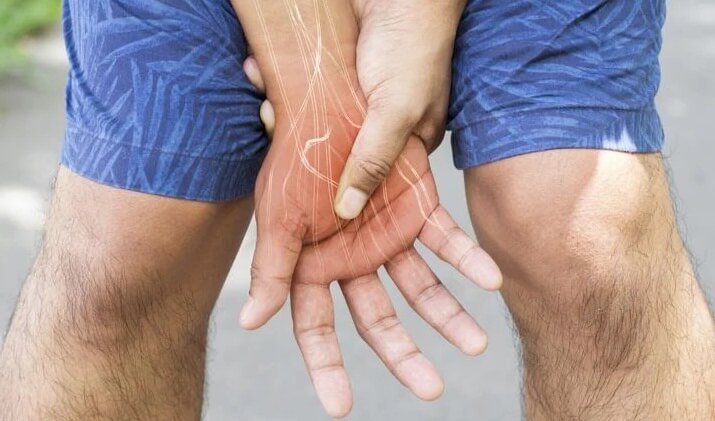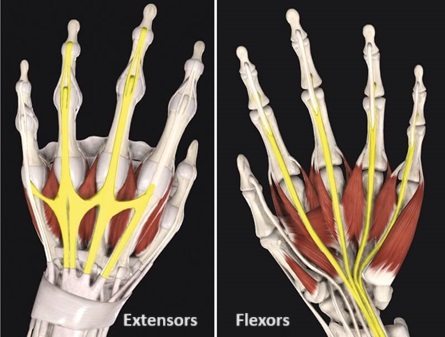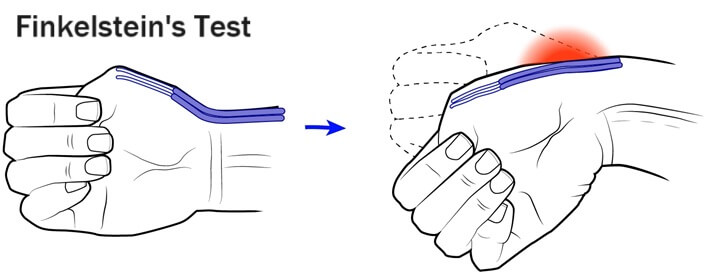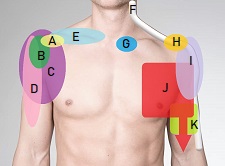- Home
- Wrist Pain Diagnosis
- Wrist Tendonitis
Tendonitis Of The Wrist
Written By: Chloe Wilson BSc (Hons) Physiotherapy
Reviewed By: SPE Medical Review Board
Tendonitis of the wrist is a common cause of wrist and hand pain.
Wrist tendonitis is where there is inflammation of one or more of the wrist tendons, usually due to small tears in the tendon from repetitive overuse or a one-off injury.
There may be pain, inflammation and stiffness in the wrist and everyday activities like picking up a drink or twisting a door knob may be painful and difficult.
Here we will look at what tendonitis of the wrist is, the common causes and symptoms, how it is diagnosed and the best treatment options for wrist tendonitis.

What Is Wrist Tendonitis?
Tendonitis of the wrist is when there is irritation or inflammation of one or more of the wrist tendons.

The wrist tendons are thick, fibrous cords made up of collagen that connect the forearm muscles to the various bones in the hand.
Tendons are surrounded by a sheath, a membrane-like structure lined with synovial fluid that allow them to slide smoothly.
There are lots of tendons around the wrist that work together to control the movement of the wrist, hand, fingers and thumb, and to stabilise the hand.
The wrist tendons fall into two groups:
- Flexor Tendons: found on the front (palm side or volar aspect) of the wrist. They help to bend the wrist and curl the fingers/thumb
- Extensor Tendons: found on the back (dorsal aspect) of the wrist. They help to extend the wrist and straighten the fingers/thumb
With tendonitis of the wrist, repetitive strain, overuse or injury can cause small micro-tearing in the tendon. The body responds by releasing inflammatory chemicals e.g. cytokines, prostaglandins and histamines. These chemicals increase blood flow to the injured area and attract white blood cells to help with the healing process. However, they also cause swelling in the tendon and surrounding tissues which places pressure on the local nerves, increasing pain.
Over time, the inflamed area may become hypersensitive so that even light pressure or movement can trigger pain signals. Chronic inflammation can lead to thickening of the tendon, known as wrist tendinosis. This thickened, less flexible tissue is more susceptible to pain and further injury.
With wrist tendonitis there may also be irritation and inflammation of the tendon sheath, known as wrist tenosynovitis. This places increased pressure on the tendon and stops it from gliding smoothly.
What Causes Tendonitis Of The Wrist?
Common causes of wrist tendonitis are:
- Repetitive Motion: Activities that involve repetitive wrist movements such as writing, typing, texting, using a computer mouse, playing video games, housework, sports e.g. racket sports, gymnastics, rock climbing or basketball, or manual labour e.g. hairdressing, operating heavy machinery or hammering, place the tendon under stress and can lead to wrist tendonitis
- Sudden Injury: A sudden impact or strain on the wrist e.g. from a fall can cause inflammation.
- Poor Posture or Technique: Improper wrist positioning during activities can place additional strain on the tendons e.g. improper desk set-up or racket grip position
- Underlying Conditions: Conditions like rheumatoid arthritis, gout, or diabetes can increase the risk of developing wrist tendonitis
- Aging: tendons are more prone to inflammation as we get older due to decreased elasticity and strength
- Smoking: reduces blood flow therefore slows down healing in the wrist tendons
- Gender: women are more than twice as likely to develop tendonitis of the wrist than men

Types Of Wrist Tendonitis
There are several types of wrist tendonitis, each affecting different tendons. The most common types of tendonitis of the wrist are:
- De Quervain's Tenosynovitis: affects the sheath of two of the thumb tendons, abductor pollicis longus (APL) and extensor pollicis brevis (EPB). De Quervain’s typically causes pain and swelling at the base of the thumb, which may worsen with thumb and wrist movement. Find Out More >
- Intersection Syndrome: involves inflammation of the wrist tendons where they cross over each other on the back of the forearm, about 2-3 inches above the wrist joint. Intersection syndrome often occurs due to repetitive wrist and hand motions, such as rowing, weightlifting, or using tools. Find Out More >
- Extensor Carpi Ulnaris Tendonitis: ECU tendonitis affects the extensor tendon that runs along the ulnar (pinky finger) side of the wrist, causing pain, swelling, and weakness along the back of the ulnar side of the wrist, especially with wrist extension and ulnar deviation. Find Out More >
- Extensor Carpi Radialis Tendonitis: ECR tendonitis involves inflammation of the tendons that extend and abduct the wrist, extensor carpi radialis longus (ECRL) and extensor carpi radialis brevis (ECRB). It causes pain and tenderness on the back of the radial (thumb) side of the wrist and forearm, which may radiate up the forearm. The pain worsens with wrist extension or gripping activities
- Flexor Carpi Radialis Tendonitis: FCR tendonitis involves inflammation of the flexor tendon that runs along the radial (thumb side) aspect of the wrist. It can cause pain, swelling, and tenderness on the front (palmar) radial side of the wrist, particularly with wrist flexion and radial deviation.
- Flexor Carpi Ulnaris Tendonitis: FCU tendonitis affects the flexor tendon that runs along the ulnar side of the wrist. It can cause pain, swelling, and tenderness on the front ulnar (pinky) side of the wrist, especially with wrist flexion and ulnar deviation.
- Flexor Digitorum Tendonitis: FD tendonitis involves inflammation of the tendons that flex the fingers, running along the palm side of the wrist. It can occur in either flexor digitorum superficialis (FDS) or the tendon just underneath it, flexor digitorum profundus (FDP).
Wrist Tendonitis Symptoms
Common symptoms of tendonitis of the wrist are:
- Pain: gradual onset of pain typically felt directly over the affected tendon but may extend into the hand and forearm. Wrist tendonitis pain is usually a dull ache that gets worse with wrist and hand movements e.g. gripping, pinching, lifting, throwing or typing, but in some cases there may be a burning or sharp, intense pain
- Swelling: visible swelling around the affected tendon, wrist and the bottom of your fingers is common with wrist tendonitis
- Tenderness: there may be tenderness directly over the tendon
- Stiffness: Reduced range of motion in the wrist and hand
- Weakness: Weakness in the wrist and difficulty gripping objects
- Crepitus: A cracking, grinding or grating sensation over the tendon when moving the wrist
- Warmth: and redness around the tendon
- Limited Activities: it may be difficult to perform certain activities such as gripping, opening jars, turning door handles and lifting things due to pain and weakness
Diagnosing Tendonitis Of The Wrist
Wrist tendonitis diagnosis involves a combination of a thorough medical history, physical examination and sometimes imaging studies.
Medical History
When diagnosing tendonitis of the wrist, the doctor will start by asking you about the nature of your symptoms, including the location, duration and intensity of the pain. They will also ask about any swelling, stiffness or weakness in the wrist, and what activities or actions seem to exacerbate the pain.
They will then ask about your daily activities, occupation and hobbies that involve repetitive wrist movement, particularly if there have been any recent changes in your activity levels. You doctor will also enquire about any history of wrist injuries or previous episodes of wrist tendonitis, as well whether you have any underlying medical conditions e.g. arthritis or diabetes.
Physical Examination
The doctor will start the physical examination for diagnosing wrist tendonitis by inspecting your wrist for any signs of redness, swelling or deformity. They will palpate the forearm, wrist and hand to identify any areas of tenderness of inflammation.
Next, they will assess your wrist and hand range of motion by asking you to move your wrist and fingers in different directions, checking for any pain, stiffness or limitations. They will also conduct strength tests to evaluate any weakness on the wrist or hand.
An important part of diagnosing tendonitis of the wrist is specific tests for tendonitis such as:
- Finkelstein's Test: Commonly used to diagnose De Quervain's Tenosynovitis, this test involves making a fist with the thumb tucked inside the fingers and then bending the wrist towards the pinky side (ulnar deviation). Pain during this movement suggests De Quervain's Tenosynovitis.
- Resisted Wrist Extension: The doctor may ask you to extend your wrist/fingers against resistance to check for pain and weakness, which can indicate extensor tendonitis.
- Resisted Wrist Flexion: The doctor may ask you to flex your wrist/fingers against resistance to check for pain and weakness, which can indicate flexor tendonitis.

Imaging Studies
In some cases, your doctor may send you for imaging studies to help diagnose wrist tendonitis, particularly if they want to rule out other conditions.
Imaging studies for tendonitis of the wrist may include:
- X-rays: to look at the wrist and hand bones for problems such as a wrist fracture or arthritis
- Ultrasound: to visualise the soft tissues and see if there is any inflammation, tendon thickening or fluid accumulation
- MRI: for more detailed images of the soft tissues and bones
Early diagnosis is really important with tendonitis of the wrist. Tendons have a relatively poor blood supply compared to other tissues, which can slow down the healing process. Without proper treatment, tendonitis of the wrist may progress to tendinosis, a chronic condition in which the tendon begins to deteriorate and where degeneration becomes the prominent feature rather than inflammation.
#CommissionsEarned from Amazon on qualifying purchases
Wrist Tendonitis Treatment
Treatment for tendonitis of the wrist may involve a combination of:
- Rest: It is really important to avoiding activities that exacerbate the pain to reduce strain and allow the tendon time to heal. Don't push through the pain with wrist tendonitis.
- Ice: Apply ice packs to reduce pain and inflammation
- Medication: Use painkillers e.g. paracetamol/Tylenol and nonsteroidal anti-inflammatory drugs (NSAIDs) e.g. ibuprofen/Advil to reduce pain and swelling as directed
- Physical Therapy: may involve manual techniques, electrotherapy e.g. ultrasound, taping and stretching and strengthening exercises for the tendons and surrounding muscles. They can also help you to modify how you do daily activities e.g. typing or lifting, to reduce the strain on the wrist tendons
- Splinting or Bracing: Immobilize the wrist, thumb or fingers in a splint, cast or brace to reduce movement and prevent further strain.
- Corticosteroid Injections: can help reduce pain and inflammation, although they do temporarily weaken the tendon so care must be taken
- Gradual Return to Activity: Slowly increase activity levels to avoid re-injuring the tendon
- Desk Set-Up: If your wrist tendonitis is linked with office work, introducing a padded wrist rest for your keyboard and mouse can make a hug difference
- Surgical Intervention: is rarely needed with wrist tendonitis unless conservative treatments fail or if there is severe tendon damage or rupture
Wrist tendonitis recovery will depend on which tendon is affected, the severity of the tendonitis, your daily activities and what treatment methods you use. In most cases, mild to moderate cases of wrist tendonitis will settle down within around 4-6 weeks with the right treatment.
More serious or chronic cases of tendonitis of the wrist can take several months to manage effectively. It is really important to follow medical advice and allow adequate time for healing to prevent recurrence of wrist tendonitis.
Tendonitis Of The Wrist Summary
Wrist tendonitis is a common cause of wrist and hand pain, and can affect any of the tendons around the wrist.
There are a number of wrist tendons that connect the forearm muscles to the hand. Wrist tendonitis can develop in any of them such as De Quervain's Tenosynovitis, Extensor Carpi Ulnaris and Intersection Syndrome.
In most cases, tendonitis of the wrist is a repetitive strain or overuse injury, but it can be caused by a one-off injury such as a fall.
Common symptoms of wrist tendonitis include localised dull pain that gets worse with wrist and hand movements, inflammation, weakness and clicking/grinding noises with wrist movements.
Activities that are often affected by tendonitis of the wrist includes opening jars or doors, computer work, sports and manual labour.
Wrist tendonitis treatment usually involves a combination of rest, medication, splinting, physical therapy and exercises.
You may also be interested in the following articles:
- Radial Wrist Pain (thumb side)
- Ulnar Wrist Pain (pinky side)
- Carpal Tunnel Syndrome
- Wrist Fractures
- De Quervain's Tenosynovitis
- Wrist Ganglion Cyst
- Wrist Pain Diagnosis Chart
Related Articles
Shoulder Problems
September 26, 2023
Diagnosis Charts
September 28, 2023
Rehab Exercises
December 12, 2023
Medical & Scientific References
- Hand & Wrist Tendinopathies. Clinical Sports Medicine Journal
- Tendon Disorders Of The Wrist And Hand. The Journal Of Hand Surgery
- De Quervain Tenosynovitis. Radiopaedia
Page Last Updated: March 4th, 2025
Next Review Due: March 4th, 2027


